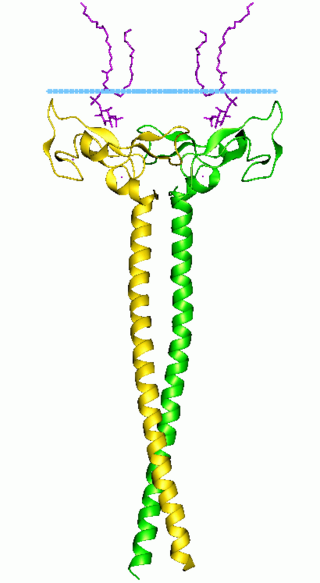
The gene EEA1 encodes for the 1400 amino acid protein, Early Endosome Antigen 1.

Ras-related protein Rab-5A is a protein that in humans is encoded by the RAB5A gene.

Hepatocyte growth factor-regulated tyrosine kinase substrate is an enzyme that in humans is encoded by the HGS gene.

Amyloid beta A4 precursor protein-binding family A member 1 is a protein that in humans is encoded by the APBA1 gene.

Signal transducing adapter molecule 2 is a protein that in humans is encoded by the STAM2 gene.

Signal transducing adapter molecule 1 is a protein that in humans is encoded by the STAM gene.

Syntaxin-6 is a protein that in humans is encoded by the STX6 gene.

STAM-binding protein is a protein that in humans is encoded by the STAMBP gene.

Amyloid beta A4 precursor protein-binding family A member 2 is a protein that in humans is encoded by the APBA2 gene.

Low-density lipoprotein receptor adapter protein 1 is a protein that in humans is encoded by the LDLRAP1 gene.

Syntaxin-12 is a protein that in humans is encoded by the STX12 gene.

SH2B adapter protein 2 is a protein that in humans is encoded by the SH2B2 gene.

Stabilin-1 is a protein that in humans is encoded by the STAB1 gene.

Rab11 family-interacting protein 5 is a protein that in humans is encoded by the RAB11FIP5 gene.

Dual adapter for phosphotyrosine and 3-phosphotyrosine and 3-phosphoinositide is a protein that in humans is encoded by the DAPP1 gene.

Ras-related protein Rab-22A is a protein that in humans is encoded by the RAB22A gene.

Target of Myb protein 1 is a protein that in humans is encoded by the TOM1 gene.

Zinc finger FYVE domain-containing protein 16 is a protein that in humans is encoded by the ZFYVE16 gene.

DCC-interacting protein 13-beta is a protein that in humans is encoded by the APPL2 gene.

Sodium/hydrogen exchanger 6 is an integral membrane protein that in humans is encoded by the SLC9A6 gene. It was originally thought to be a mitochondrial-targeted protein, but subsequent studies have localized it to the plasma membrane and recycling endosomes.




























